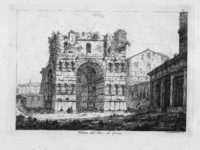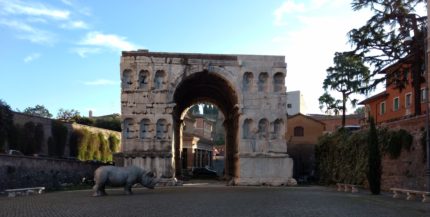In the Forum Boarium across from the Theater of Marcellus and a block or so from Santa Maria in Cosmedin where crazy people who have seen Roman Holiday one too many times line up for hours to get a picture of themselves putting their hands in an ancient manhole cover, lies one of those gems that is so large it’s weird to call it hidden. And yet it is, at least in the sense of being little known these days.
It is the only surviving quadrifrons arch in Rome. Quadrifons literally means “four fronts” and that’s how the arch was designed: four pylons supporting a cross vault, like the way you set up the central double wicket in croquet. That gives it the look of a cube with a gate on each side. It’s the four faces that earned it the appellation Arch of Janus, a deity sometimes depicted in Roman iconography in the form of Ianus Quadrifons, so with four faces instead of two. The arch wasn’t dedicated to him. The Latin word for door, “ianua,” is derived from the god and is the likely reference in the name.
There are no records of it going by the Arch of Janus in antiquity. Historians think it might be the “arcum divi Constantini” listed as one of the monuments in the Velabrum in the regionary Notitia urbis Romae in which case it would have been dedicated to Constantine or his one of his sons Constantine II, Constans or Constantius II.
The arch was built in the second half of the 4th century A.D. in the Velabrum, the valley connecting the Roman Forum with the Forum Boarium (the cattle market). Once a marsh fed by the Tiber, the area was drained by the construction of the Cloaca Maxima, and the arch straddles the large drain leading to the great sewer. It was constructed of concrete and faced with marble taken from earlier structures. The marble cladding of the pylons have two rows of three niches on each side. Empty now, they originally contained statues. Today the only figural decoration remaining is a different goddess on each keystone: Roma on the east pylon, Minerva on the north, and possibly Juno and Ceres on the remaining two (identification is uncertain).
 In the Middle Ages the Frangipani family occupied it, filling in the gates and using it as a fortress. Those alterations were corrected in 1827-1830 and the arch became an arch again. There was just one wee little problem. The restorers mistakenly believed that an attic atop the arch was a Frangipani addition and tore the whole thing off. It was original, part of the ancient arch now lost forever.
In the Middle Ages the Frangipani family occupied it, filling in the gates and using it as a fortress. Those alterations were corrected in 1827-1830 and the arch became an arch again. There was just one wee little problem. The restorers mistakenly believed that an attic atop the arch was a Frangipani addition and tore the whole thing off. It was original, part of the ancient arch now lost forever.
Through the opening of the gates you can see the church of San Giorgio al Velabro right behind it. In 1993, a car bomb went off in front of the church, after which the arch was fenced in and visitors locked out. While other buildings in the Velabrum were restored in the 90s and early 2000s, the arch alone remained untouched, blackening under the constant assault of Roman traffic. It was included in the World Monuments Fund 2014 World Monuments Watch, and with funding from private sponsors, the WMF and the Superintendency for the Coliseum were able to start an in-depth study and restoration of the arch.
In May of 2017, visitors were invited to see the work in progress at a WMF-organized Watch Day. This video shows tantalizing but not satisfying snippets of the restoration.
A year and a half has passed since that Watch Day, and as of 9:00 AM October 24th, 2018, the Arch of Janus is still fenced in. A sign on the gate warns that visitors are not allowed due to the ongoing restoration work. There was no work visible. No workers. No scaffolding. There was, however, a rhino.

Rome, ladies and gentlemen.
:ohnoes: Sorry, but in comparison to the ones from the Torre Largo Argentina, it has to be said, this particular cat in front of that arch is quite a strange one! Obviously, there is not even fur, or is it?!?
Is that a living breathing rhino???
“Forum Boarium” is a fantastic name which I shall henceforth use when among groups of single people as well as in situations soporific.
Hi!
I was in Rome last May and was wandering around Forum Boarium when I spotted this very arch. I took a couple of pictures of it but as you said, it was fenced in 🙁 I have been trying to find more info on this arch, and thanks to you! I finally know what it is and what it’s called. Thank you!
Your blog is awesome. I’m going to spend all of my free time reading your blog now.